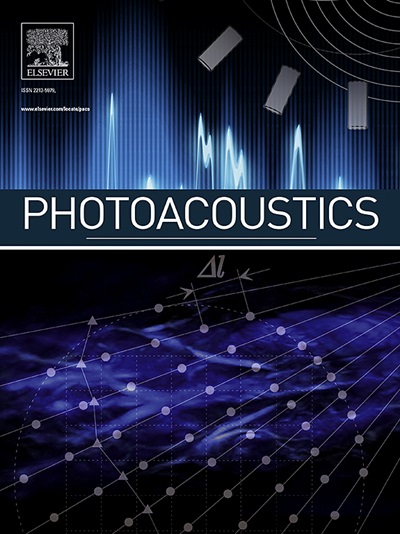Robust and compact light-induced thermoelastic sensor for atmospheric methane detection based on a vacuum-sealed subminiature tuning fork
IF 6.8
1区 医学
Q1 ENGINEERING, BIOMEDICAL
引用次数: 0
Abstract
A compact light-induced thermoelastic spectroscopy (LITES) instrument incorporating a subminiature quartz tuning fork (QTF) was developed for atmospheric methane (CH4) sensing. The QTF features prong dimensions of 1700 µm in length and 120 µm in width, which enable substantial thermoelastic expansion at the microscale, significantly enhancing the piezoelectric signal. The subminiature QTF was vacuum sealed to achieve a high quality factor of 20,511 and a temperature coefficient of frequency of − 0.91 ppm/℃, ensuring a high detection sensitivity and robustness for the LITES sensor. Under identical vacuum conditions, the subminiature QTF demonstrated a twofold signal enhancement compared to the standard QTF, resulting in a minimum detection limit (MDL) of 47 ppb with a 300-ms averaging time. Continuous measurements of atmospheric CH4 levels over five days were conducted to evaluate the accuracy and robustness of the developed sensor for long-duration monitoring applications.
基于真空密封微型音叉的大气甲烷检测光致热弹性传感器
采用微型石英音叉(QTF),研制了一种用于大气甲烷(CH4)传感的紧凑型光致热弹性光谱(LITES)仪器。QTF的尖头尺寸为1700 µm长,120 µm宽,可以在微尺度下进行大量的热弹性膨胀,显著增强压电信号。该微型QTF采用真空密封,质量系数为20,511,温度系数为- 0.91 ppm/℃,确保了LITES传感器的高检测灵敏度和鲁棒性。在相同的真空条件下,与标准QTF相比,超小型QTF表现出两倍的信号增强,导致最小检测限(MDL)为47 ppb,平均时间为300 ms。对5天的大气CH4水平进行了连续测量,以评估所开发的传感器在长时间监测应用中的准确性和稳健性。
本文章由计算机程序翻译,如有差异,请以英文原文为准。
求助全文
约1分钟内获得全文
求助全文
来源期刊

Photoacoustics
Physics and Astronomy-Atomic and Molecular Physics, and Optics
CiteScore
11.40
自引率
16.50%
发文量
96
审稿时长
53 days
期刊介绍:
The open access Photoacoustics journal (PACS) aims to publish original research and review contributions in the field of photoacoustics-optoacoustics-thermoacoustics. This field utilizes acoustical and ultrasonic phenomena excited by electromagnetic radiation for the detection, visualization, and characterization of various materials and biological tissues, including living organisms.
Recent advancements in laser technologies, ultrasound detection approaches, inverse theory, and fast reconstruction algorithms have greatly supported the rapid progress in this field. The unique contrast provided by molecular absorption in photoacoustic-optoacoustic-thermoacoustic methods has allowed for addressing unmet biological and medical needs such as pre-clinical research, clinical imaging of vasculature, tissue and disease physiology, drug efficacy, surgery guidance, and therapy monitoring.
Applications of this field encompass a wide range of medical imaging and sensing applications, including cancer, vascular diseases, brain neurophysiology, ophthalmology, and diabetes. Moreover, photoacoustics-optoacoustics-thermoacoustics is a multidisciplinary field, with contributions from chemistry and nanotechnology, where novel materials such as biodegradable nanoparticles, organic dyes, targeted agents, theranostic probes, and genetically expressed markers are being actively developed.
These advanced materials have significantly improved the signal-to-noise ratio and tissue contrast in photoacoustic methods.
 求助内容:
求助内容: 应助结果提醒方式:
应助结果提醒方式:


